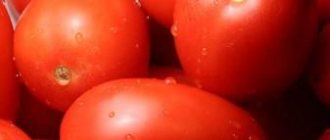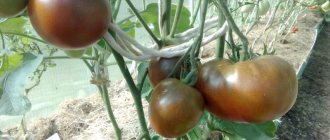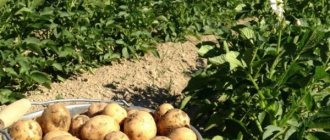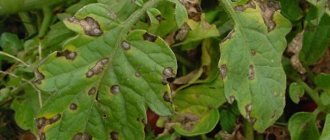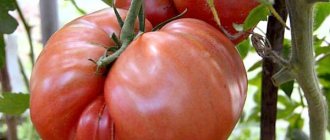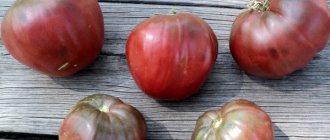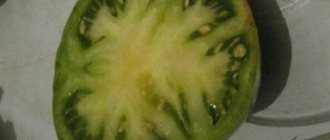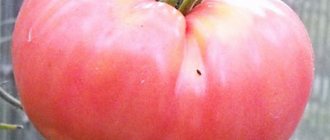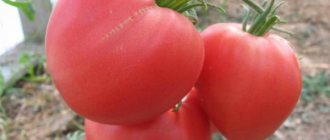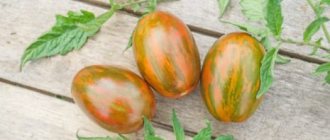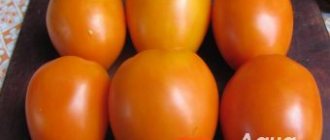Description and characteristics of the variety
The Malachite Box tomato was bred in 2006 by breeders from Novosibirsk. It was immediately included in the State Register of Breeding Achievements of the Russian Federation. It is designed for cultivation in the harsh conditions of Siberia and northern regions. The variety is endowed with all the qualities that contribute to obtaining a decent harvest.
- Indeterminate tall variety. Plants grow up to 1.5 meters in height. It is necessary to pinch the top of the main stem and tie it to a support or trellis as it grows.
- Medium leafy, large dark green leaves.
Important! The variety is not resistant to diseases and pests, so additional prevention is required.
- The inflorescences are simple, collected in a raceme. The joints on the stalk are clearly visible. Almost all ovaries form into fruits that grow along the entire length of the stem.
- It is recommended to grow in 1 stem.
- Productivity is high. In a greenhouse with 1 sq. meter you can collect up to 15 kg of ripe vegetables. In open ground, the yield is much lower - only 4 kg of tomatoes from a plot of the same area.
More about the variety
The characteristics of tomatoes speak about their characteristics and the conditions that they prefer. Tomatoes of the Malachite Box variety are created for experimenters and lovers of original crops. They are grown mainly in greenhouses if the summer is not very hot. Fruit ripening and yield can be considered average. They do not ripen at the same time, but you can enjoy the fruits gradually until autumn.
The fruits are soft, juicy, and their taste is sometimes described as if the aroma of melon mixed with kiwi. Thanks to this taste and aroma they are grown. And how they complement the rest of the vegetables and fruits in the salad! Tomatoes are quite large, their weight ranges from 100 to 400 grams. Their pulp is juicy, sweet, and the skin is thin.
They are very delicate, so they are poorly stored and can crack during transportation. For those who prefer to can tomatoes, this variety is unlikely to be suitable.
The name comes from the unusual color of the tomato; it is striped green with a yellow tint, as if someone had painted patterns on it. The cut shows exactly the same color, not monochromatic, striped. This variety is ideal for those who are allergic to red vegetables, as it is completely safe. It can be given to small children. After all, it contains so many vitamins and minerals. Moreover, they really like them, because the taste is very different from standard tomatoes.
Since the bush grows densely and is quite tall, it is customary to tie it up. Sometimes it can reach up to two meters. These tomatoes are quite capricious to care for, so initially you need to show patience and care in order to get the desired tasty fruits.
Features of caring for nolina recurvata at home
Fruit characteristics
- Beautiful appearance.
- High taste qualities. There are notes of ripe melon, juicy kiwi, and light sourness.
- The shape is round, slightly flattened.
- Ripe fruits are yellow, green, green-yellow. Emerald patterns are clearly visible on the skin.
- One tomato weighs about 300-400 g, but individual specimens can gain weight up to 900 g.
- The pulp is dense, juicy, yellow-green in color.
- Can be used by allergy sufferers who cannot eat red fruits.
- The skin is thin and tender.
- Poorly stored.
- Cannot be transported over long distances.
Care
Plants should be formed into 1-2 stems. Stepchildren are cut off as they grow and the leaves are removed before the first inflorescences appear. The same is done after fruit set. To prevent the clusters with filling fruit from breaking under their own weight, additional garter is required.
Further care consists of regular watering, removing weeds and loosening the soil. For better moistening of the beds, weed control and additional fertilizing, mulching with straw or seedless grass clippings is recommended. To prevent late blight, you can spray the plants with a 1% solution of copper sulfate 3-4 times a season.
Photo
Below are photos of tomatoes of the Malachite Box variety .
Gardeners' opinions
Reviews from those who planted this type of tomato are always positive. Among the advantages are long-term fruiting, unique taste, beautiful color, resistance to fungal diseases, and changes in weather conditions. Those who have grown such tomatoes are always surprised by their delicate taste. They make excellent jam.
But they are not at all suitable for sale or transportation, as they quickly rot, wrinkle and crack on the sides. This is not even a disadvantage, but their feature. Therefore, if there is a need to salt tomatoes in jars for the winter, transport tomatoes over long distances, or sell them on the market, then you should choose some other simpler variety. And these can be planted in several bushes for fresh eating.
Malachite box is a variety of tomatoes that have very tasty and beautiful fruits. If you take into account all the requirements for planting and growing these tomatoes, then every year you can enjoy this wonderful taste in a salad.
Advantages and disadvantages
Malachite Box tomatoes, like other varieties, have their own advantages:
- Stable and high yield.
- Long-term fruiting.
- Almost 100% fruit set.
- Exotic taste and color. These tomatoes are added to fruit salads.
- Hypoallergenic. Recommended for use by children and allergy sufferers.
- High content of micro- and macroelements.
- Suitable for cultivation in open and closed ground.
- The fruits do not crack.
- Resistant to diseases, especially late blight.
- Variety, so you can collect seeds for cultivation, as they retain varietal properties.
The disadvantages include the following qualities:
- This variety requires careful care.
- Thin skin does not allow tomatoes to be transported over long distances.
- Has poor keeping quality. It is better to process the harvested crop immediately.
- When overripe, the taste deteriorates. The fruits become watery.
Tomatoes Malachite box on video
If you grew Malachite Box tomatoes, please write how you liked them. What was the yield and taste of the fruit? Will you grow them again? How do you assess a variety's resistance to disease? If possible, attach to the comment a photo of the entire bush as a whole or individual fruits that you grew. Thank you!
Your additions to the description will help many gardeners evaluate this variety more objectively and decide whether it is worth planting or not.
This is a natural variety of tomato. Therefore, we recommend taking seeds from a ripe fruit and using them for planting in subsequent seasons.
Features of cultivation
The tomato variety Malachite Box was bred for cultivation in all regions of Russia (Siberia, the Urals, the Moscow region and the South). However, Russia is a large country and the climatic conditions in different areas are also different. Therefore, in colder areas it is better to grow this variety in a greenhouse.
The variety is early ripening and the fruits ripen 100 days after sowing the seeds. However, it is recommended to give preference to the seedling method of growing Malachite Box tomatoes.
Advice! It is better to sow seed 55-60 days before planting in the ground.
A substrate of fertile soil and old humus, taken in equal quantities, is poured into the prepared container. Furrows 1-2 cm deep are made in the ground at intervals of 3 cm. Seeds are sown in them at a distance of 2 cm from each other. The containers are covered with film and placed in a warm place where the temperature is kept within 25 degrees. When small sprouts appear on the surface of the earth, the film is removed and the containers are transferred to a well-lit place. This will happen literally in 3-6 days. The air temperature in the room is reduced to 17 degrees for 3 days so that the seedlings do not stretch.
Picking into separate cups is carried out after the seedlings have formed 2-3 true leaves.
Before planting in the main place, Malachite Box tomatoes must be hardened 10-14 days before planting. To do this, the seedlings are taken outside every day, gradually increasing the residence time.
The seedlings are transplanted into the greenhouse at the end of May, and into open ground after June 10. It is advisable to prepare the soil for planting in the fall. However, this can be done 2 weeks before planting the seedlings.
On the day of transplantation, dig holes, pour boiling water with potassium permanganate into them to disinfect the soil, and lay out one seedling at a time.
Planting scheme: per 1 sq. 2 meter bush. A support is installed near each seedling for tying up growing bushes. Plantings are watered with warm water.
More information about growing tomatoes is described in the article: Technology of growing tomatoes. Secrets of planting and care
You might be interested in: How to properly plant tomatoes in a greenhouse: bush formation diagram, care features, photos and videos
Useful information: How to properly tie tomatoes in open ground: the best methods, step-by-step photo and video instructions
How to care
Like all tomatoes, the Malachite Box requires special care so that the vegetables ripen faster. It is best to plant them in open ground as mature green seedlings. These seedlings are grown on a windowsill in a seed box. In order for the seeds to hatch faster, they should be treated in a special fertilizer for growth; it will help to form immunity against many diseases and pests in advance.
The stem is characterized by strong branching, so you can trim off excess shoots to achieve rapid fruiting. This is called stepsoning.
Mature tomatoes also need to be fed when flowers appear on them. Among the fertilizers, the Malachite Box prefers superphosphate, ammonium nitrate, potassium minerals, humus, manure, and chicken droppings. The humidity in the greenhouse is well maintained by a bucket of soaked grass.
If tomatoes are planted in open ground, then it is better to cover them with film at night or in cloudy weather. Planting in the northern regions is carried out in May, when the ground is already warmed by the sun and well dug up. It must be loose and soft, otherwise the plant will grow slowly due to poor nutrition. Be sure to weed at least once a month. They draw energy and nutrition from tomatoes and transfer insects to them.
These varieties are susceptible to attack by harmful insects: aphids, beetles, caterpillars. For prevention, it is necessary to spray the leaves with a special solution once a month. If at least one diseased tomato is noticed, it must be picked immediately. Otherwise he will infect others.
High-quality watering is required. But it should be stopped a week before harvest, otherwise the tomatoes will rot. Severely overripe tomatoes become watery, so it is important to remove them from the bush and eat them in time.
